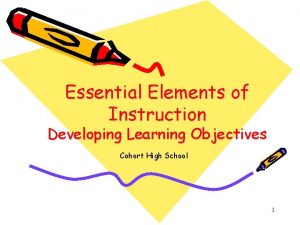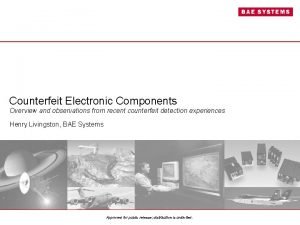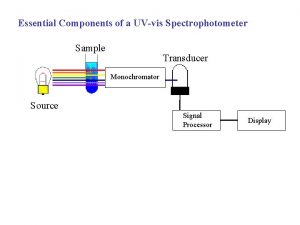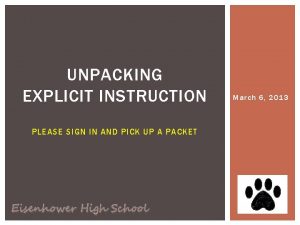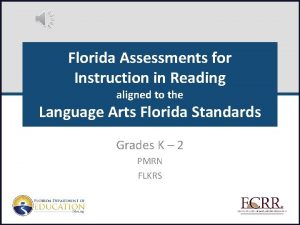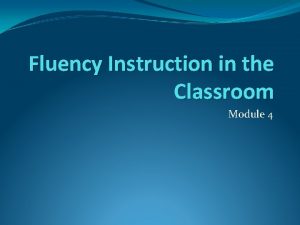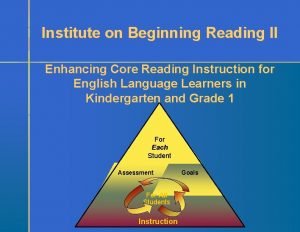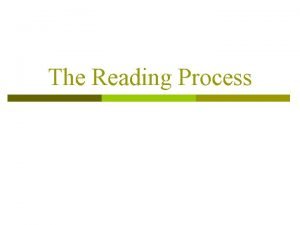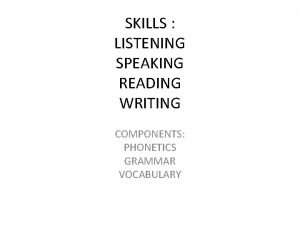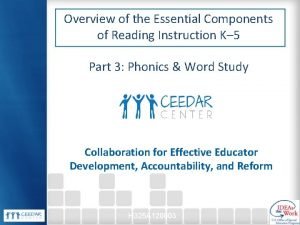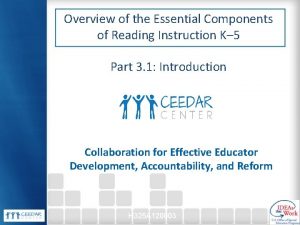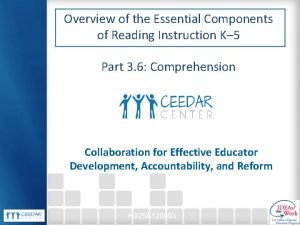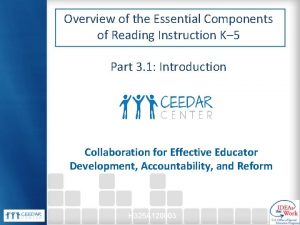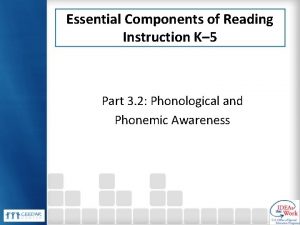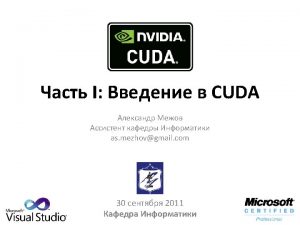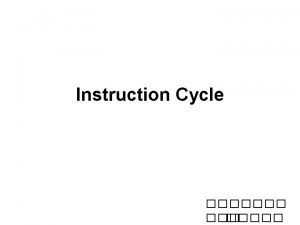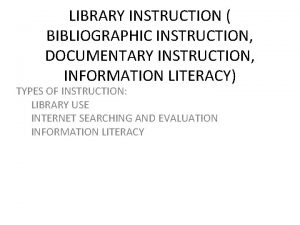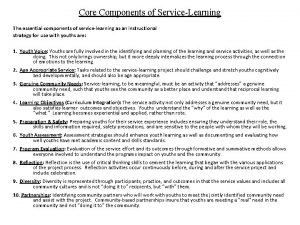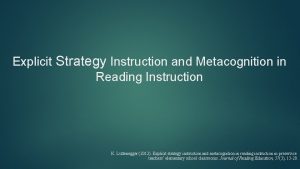Overview of the Essential Components of Reading Instruction







































































- Slides: 71

Overview of the Essential Components of Reading Instruction K– 5 Part 3. 5: Vocabulary Collaboration for Effective Educator Development, Accountability, and Reform H 325 A 120003

Overview of the Essential Components of Reading Instruction K– 5 Part 3. 5: Vocabulary A special thanks to the Meadows Center for Preventing Education Risk at the University of Texas at Austin for permission to use and adapt material from a module created by the Higher Education Collaborative: Foundations of Reading Instruction. © 2009 University of Texas System/Texas Education Agency www. meadowscenter. org H 325 A 120003

Big Ideas & Questions 1. What is the idea? Why is it important? What does the research say? 2. What should students know and be able to do at each grade level? 3. How do we assess what students know and the progress they are making?

Big Ideas & Questions 4. How do we teach the big idea effectively and efficiently? 5. How do we develop instructional plans that incorporate standards, assessment data, and evidence-based instructional strategies? 6. What do we do if students are not learning the big idea?

Module Outcomes 1. Design instruction for all students. 2. Differentiate instruction. 3. Use assessment data to inform instruction, form groups, and monitor progress. 4. Incorporate standards and evidence-based practices (EBPs).

Major Reports

National Reading Panel Elements of Reading Instruction 1. 2. 3. 4. 5. Phonemic awareness. Phonics. Fluency. Vocabulary. Text Comprehension.

The Reading Rope

Overview of the Essential Components of Reading Instruction K– 5 Part 3. 5: Vocabulary A special thanks to the Meadows Center for Preventing Education Risk at the University of Texas at Austin for permission to use and adapt material from a module created by the Higher Education Collaborative: Foundations of Reading Instruction. © 2009 University of Texas System/Texas Education Agency www. meadowscenter. org H 325 A 120003

Essential Components of Reading Instruction K-5 Part 3. 5: Vocabulary v. DYNAMIC v. POWERFUL v. EFFECTIVE

What If. . . ? Your students have learned: • Concepts of phonemic awareness. • How to decode with fluency. And they still do not comprehend what they read?

Essential But Not Taught… Despite the importance of vocabulary development, very little instructional time is devoted to vocabulary instruction in the primary grades. Yet, we know what to do. . . Baumann et al. , 2003; Biemiller, 2001; Foorman & Schatschneider, 2003; Pearson et al. , 2007

Assessing Your Vocabulary 1 Never saw it 2 Heard of it Insouciant sagacious Adapted from Dale, 1965 3 Know in context polyglot hubris 4 Know it well

Common Core Standards • Interpret words and phrases as they are used in a text, including determining technical, connotative, and figurative meanings, and analyze how specific word choices shape meaning or tone. Common Core State Standards, Anchor Standards for Reading, Craft & Structure, p. 10

CCSS • Determine or clarify the meaning of unknown and multiple-meaning words and phrases by using context clues, analyzing meaningful word parts, and consulting general and specialized reference materials. • Demonstrate understanding of figurative language, word relationships, and nuances in word meanings. • Acquire and use accurately a range of general academic and domain-specific words. Common Core State Standards, ELA, pp. 28 -29

Vocabulary • Size in kindergarten predicts reading comprehension in middle grades. • Size at the end of first-grade predicts comprehension 10 years later. • Lack in third grade relates to lower comprehension scores in upper grades. Biemiller, 2001; Cunningham & Stanovich, 1997, 1998; Nagy, 2005; National Reading Panel, 2000; The National Research Council , 1998

Vocabulary/Comprehension Indeed, one of the most enduring findings in reading research is the extent to which students’ vocabulary knowledge relates to their reading comprehension (Lehr et. al. , p. 3). Anderson & Nagy, 1991; Farstrup & Samuels, 2008; Hiebert & Kamil, 2005; Lehr et al. , 2004; Marzano, 2004; Nagy, 1998, 2005


Comprehensive Approach • Teach specific, carefully selected words. • Increase exposure to rich oral and written language. • Increase generative word knowledge. Blachowicz & Fisher, 2005; Bear et al. , 2014; Ebbers, 2003; Farstrup & Samuels, 2008; Stahl & Nagy, 2006; Stahl & Stahl, 2004;

3 Principles of Vocabulary Instruction 1. Multiple exposures. 2. With deep understanding. 3. Connected to what students know. Archer, A. 2004;

Wide Reading Helps. . . But Research has shown that children who read even 10 minutes a day outside of school experience substantially higher rates of vocabulary growth between second and fifth grade than children who do little or no reading. Anderson & Nagy, 1992, p. 46


Choosing Words Tier I: Basic words that most students know: Baby, clock, happy Tier II: High-frequency words: Coincidence, absurd, industrious Tier III: Low-frequency words from specific domains isotope Beck et al. , 2002, 2008

Tier II Words • Are important. • Are used frequently. • Have instructional potential. • Promote conceptual understanding. Beck et al. , 2002

My Father, the Entomologist “Oh, Bea, you look as lovely as a longhorn beetle lifting off for flight. And I must admit, your antennae are adorable. Yes, you’ve metamorphosed into a splendid young lady. ” My Father, the Entomologist Bea rolled her eyes and muttered, “My father, the entomologist. ” I heard that, Bea. It’s not nice to mumble. Unless you want to be called a. . . Mumble Bea!” Beck et al. , 2002, pp. 20 -21

My Father, the Entomologist continued The first day of fifth grade, and my father tells me I look like a longhorn beetle. Bea shuddered at the thought. She absolutely detested bugs. Why does Dad have to be obsessed with insects? She wondered. Why not football or golf like most fathers? The answer was simple. Bea’s dad was weird. . . And he had made Bea weirdest of all when he named her Bea Ursula Gentry. . . B. U. G. Beck et al. , 2002, pp. 20 -21

Assigning Words to Tiers Tier II splendid muttered mumble shuddered detested obsessed Beck et al. , 2002 Tier III longhorn beetle antennae metamorphosed entomologist

Morphological Awareness • Morphology is the study of word formation. • Morphemes are units of meaning. • By age 10, morphological awareness (MA) is a strong predictor of reading skill. Carlisle, 2010; Ebbers, 2012; Singson et al. , 2000

Morphemes • Includes prefixes and suffixes: – Inflectional. – Derivation. • Compound words: – Create a new concept. – Typically right word is the category. • 88, 500 morphological word families: – Same root. – Semantically similar. – Examples: act, action, active, react, enact Hougen & Ebbers, 2012; Nagy & Anderson, 1984

When to Teach New Words • In grades K-2, it may be best to teach the words after a story is read. • While reading, provide a brief explanation. • Context of story provides rich examples of word meanings. Archer & Hughes, 2011

When to Teach New Words • If the word is essential to the meaning of the text to be read, teach the meaning of the word before reading and reinforce the meaning after reading. • If words can be learned using context clues, teach students what to look for in the text to discern the meaning.

Embedded Vocabulary • Provide quick definitions or synonyms. • Do not interfere with the storyline. • Use the word when questioning. Archer & Hughes, 2011; Coyne et al. , 2007; Robbins & Ehri, 1994;

Embedded Instruction 1) Identify practices used to teach novel words. 2) Identify procedures that support students’ comprehension of the book. 3) Note other instructional procedures that were beneficial. ache village concentrate Archer & Hughes, 2011; Coyne et al. , 2007

Explicit Instruction Partner 1: What instructional steps were used to introduce each of the vocabulary words? Partner 2: What other good instructional practices did you observe?

Application Practice • Three Tier I words (white). • Five Tier II words (yellow). • Three Tier III words (blue).

Application Practice • Teach two Tier II words to your partner. • Follow the model discussed: o Introduce the word. o Student friendly definition. o Illustrate with examples. o Check students’ understanding. • Provide 12 or more exposures to the word!

Instructional Strategies • Actively engage students. • Are appropriate for various skill levels. • Provide multiple exposures. • Allow deep understanding. • Are connected to what they know. Archer & Hughes, 2011; Baumann & Kame’ennui, 2004

Differentiation • How can you adapt each strategy to ensure all students benefit? • How can you make the strategy more explicit and systematic?

Direct Instruction: ante The prefix ante means “before. ” – Antebellum: before a war (Civil War) – Ante meridiem: before noon (a. m. ) – Anteroom: ? ?

Dr. De Soto • timid • morsel • protect Steig, 1992

Dr. De Soto • timid • morsel • protect Steig, 1992

Dr. De Soto • timid • morsel • protect Steig, 1992

Synonym Toss 1. Form groups of four to six people. 2. Throw a small ball to one another. 3. The receiver says a synonym for the listed word. 4. When no new synonyms can be added, move to the next word.

Word Tiers sagacious wise learned erudite astute educated intelligent tired says house delicious

Pinch Papers Banter 1 A couple argue about what to have for dinner. Berate 1 A police officer yells at a drive blocking traffic. 2 A couple joke about who ate more at dinner. 2 A police officer calls a tow truck to move a car blocking traffic.

Who Has Hubris? 1 Mother Teresa founded orphanages. 2 A politician said he could solve all the problems in the world.

There’s the Pinch! their they’re there

MA pneumonoultramicroscopicsilicovolcanoconiosis Because of his proximity to Mt. St. Helens, he contracted pneumonoultramicroscopicsilicovolcanoconiosis. Ebbers, 2003; Lederer, 1998

Prefixes and Suffixes Prefix Root Suffix in dict ing

Prefixes and Suffixes Prefix Root Suffix in dict ing

Prefixes and Suffixes Prefix Root Suffix in dict ing

Not So Helpful. . . • The “spray and pray” approach. • Saying a word over and over. • Looking up definitions and writing sentences.

Verbal/Visual Associations 1. Draw a square with four boxes. 2. Write the word in the top-left box. 3. Write the definition in the bottom-left box. 4. Write a personal association in the top-right box. 5. Write an antonym or non-example in the bottom-right box. Adapted from Frayer et al. , 1969

Verbal/Visual Associations salubrious surfing promoting health smoking Frayer et al. , 1969

You Try It!

Word Line crawl, sprint, jog, run, stroll, meander crawl meander stroll walk jog run sprint ___________________ Beck, Mc. Keown, & Kucan, 2002

You Try It! • meander • run • crawl • sprint • trudge • jog • amble • stroll • saunter • dash







Inside-Out Strategy 1. Look outside the word at context clues in neighboring words and sentences. 2. Look inside the word at the word parts (prefix, root, suffix). 3. Re-read the entire context, keeping the word parts in mind. 4. Make an inference: What do you think the word means? Does it make sense? Ebbers & Denton, 2008

Model “Inside-Out” The director made a unilateral decision. He canceled the annual company picnic without discussing it with his managers, which made them angry. Listen to me model. Select a text and model for your partner.

Many Other Strategies • Semantic Feature Analysis. Heimlich & Pittelman, 1986 • Games, acting, pictures, stories. • Word Associations. • Word Walls and Word Banks.

Word Consciousness An interest in and awareness of words and phrases. Word consciousness is an obligatory, not an optional, component of vocabulary instruction. Nagy, 2007; Scott & Nagy, 2004; Stahl & Nagy, 2006; Stahl & Stahl, 2004

Graves’ Four Components 1. Provide rich and varied language experiences. 2. Teach individual words. 3. Teach word-learning strategies. 4. Foster word consciousness. Baumann et al, 2007; Graves 2000, 2006; Scott et al. , 2008; Scott & Nagy, 2004;

Graves’ Four Components 1. Provide rich and varied language experiences. 2. Teach individual words. 3. Teach word-learning strategies. 4. Foster word consciousness. Baumann et al, 2007; Graves 2000, 2006; Scott et al. , 2008; Scott & Nagy, 2004;

Assessing Your Vocabulary 1 Never saw it Insouciant sagacious 2 Heard of it 3 Know in context polyglot hubris 4 Know it well

3– 2– 1 Blast Off 3 Things principles you learned. 2 Vocabulary activities you will use. 1 Question you have.
 Pre reading while reading and post reading activities
Pre reading while reading and post reading activities Plamatic acid
Plamatic acid Essential elements of instruction
Essential elements of instruction Individualized instruction vs differentiated instruction
Individualized instruction vs differentiated instruction What is direct instruction strategy
What is direct instruction strategy Counterfeit electronic components an overview
Counterfeit electronic components an overview Parts of spectrophotometer
Parts of spectrophotometer Components of explicit instruction
Components of explicit instruction Florida assessments for instruction in reading
Florida assessments for instruction in reading Fluency oriented reading instruction
Fluency oriented reading instruction Enhanced core reading instruction
Enhanced core reading instruction Components of reading process
Components of reading process Scarborough reading rope pdf
Scarborough reading rope pdf Grammar listening speaking reading writing
Grammar listening speaking reading writing Elar mc meaning
Elar mc meaning Hát kết hợp bộ gõ cơ thể
Hát kết hợp bộ gõ cơ thể Bổ thể
Bổ thể Tỉ lệ cơ thể trẻ em
Tỉ lệ cơ thể trẻ em Gấu đi như thế nào
Gấu đi như thế nào Chụp phim tư thế worms-breton
Chụp phim tư thế worms-breton Alleluia hat len nguoi oi
Alleluia hat len nguoi oi Môn thể thao bắt đầu bằng chữ đua
Môn thể thao bắt đầu bằng chữ đua Thế nào là hệ số cao nhất
Thế nào là hệ số cao nhất Các châu lục và đại dương trên thế giới
Các châu lục và đại dương trên thế giới Công thức tiính động năng
Công thức tiính động năng Trời xanh đây là của chúng ta thể thơ
Trời xanh đây là của chúng ta thể thơ Mật thư anh em như thể tay chân
Mật thư anh em như thể tay chân 101012 bằng
101012 bằng Phản ứng thế ankan
Phản ứng thế ankan Các châu lục và đại dương trên thế giới
Các châu lục và đại dương trên thế giới Thể thơ truyền thống
Thể thơ truyền thống Quá trình desamine hóa có thể tạo ra
Quá trình desamine hóa có thể tạo ra Một số thể thơ truyền thống
Một số thể thơ truyền thống Bàn tay mà dây bẩn
Bàn tay mà dây bẩn Vẽ hình chiếu vuông góc của vật thể sau
Vẽ hình chiếu vuông góc của vật thể sau Biện pháp chống mỏi cơ
Biện pháp chống mỏi cơ đặc điểm cơ thể của người tối cổ
đặc điểm cơ thể của người tối cổ V cc cc
V cc cc Vẽ hình chiếu đứng bằng cạnh của vật thể
Vẽ hình chiếu đứng bằng cạnh của vật thể Tia chieu sa te
Tia chieu sa te Thẻ vin
Thẻ vin đại từ thay thế
đại từ thay thế điện thế nghỉ
điện thế nghỉ Tư thế ngồi viết
Tư thế ngồi viết Diễn thế sinh thái là
Diễn thế sinh thái là Các loại đột biến cấu trúc nhiễm sắc thể
Các loại đột biến cấu trúc nhiễm sắc thể So nguyen to
So nguyen to Tư thế ngồi viết
Tư thế ngồi viết Lời thề hippocrates
Lời thề hippocrates Thiếu nhi thế giới liên hoan
Thiếu nhi thế giới liên hoan ưu thế lai là gì
ưu thế lai là gì Sự nuôi và dạy con của hổ
Sự nuôi và dạy con của hổ Sự nuôi và dạy con của hươu
Sự nuôi và dạy con của hươu Sơ đồ cơ thể người
Sơ đồ cơ thể người Từ ngữ thể hiện lòng nhân hậu
Từ ngữ thể hiện lòng nhân hậu Thế nào là mạng điện lắp đặt kiểu nổi
Thế nào là mạng điện lắp đặt kiểu nổi St. louis
St. louis Aims and objectives of teaching
Aims and objectives of teaching Reading techniques and strategies
Reading techniques and strategies Edb net
Edb net Why is critical thinking an active process? *
Why is critical thinking an active process? * Real definition of extensive reading
Real definition of extensive reading Intensive and extensive reading
Intensive and extensive reading What is reading
What is reading Www description
Www description Maximo overview
Maximo overview Universal modelling language
Universal modelling language Uml overview
Uml overview Vertical retailer
Vertical retailer Figure 12-1 provides an overview of the lymphatic vessels
Figure 12-1 provides an overview of the lymphatic vessels Pulmonary circuit
Pulmonary circuit


